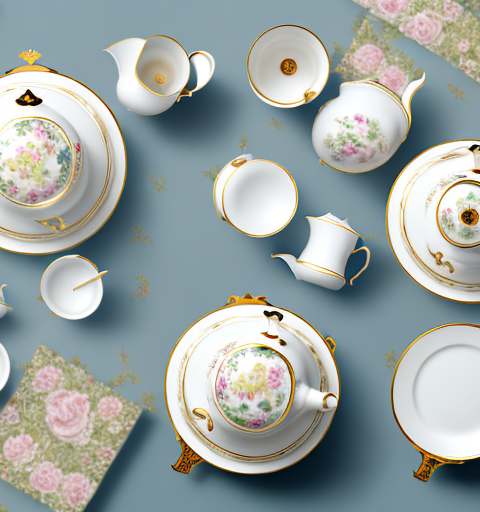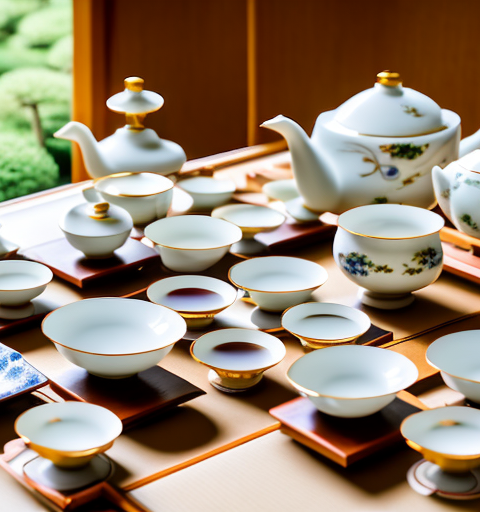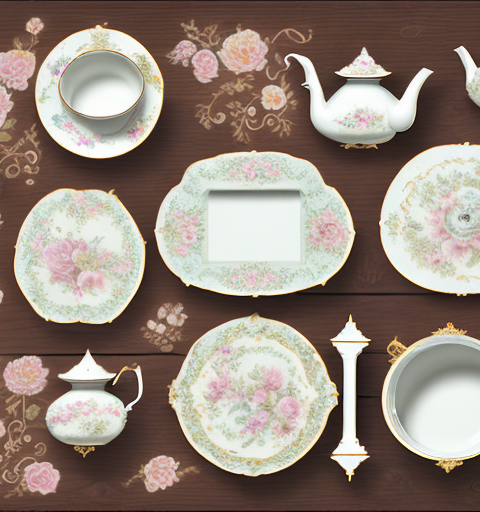Ceramic teapots are a popular choice among tea enthusiasts for their aesthetic appeal and ability to retain heat. However, when it comes to cleaning and maintenance, many people wonder if these delicate vessels can be safely washed in a dishwasher. In this comprehensive article, we will explore the dishwasher-safety factor of ceramic teapots, providing an in-depth guide to their compatibility with dishwashers. We will also discuss the pros and cons of cleaning ceramic teapots in dishwashers, and examine the impact of dishwasher cleaning on their longevity. Additionally, we will highlight the factors that need to be considered before putting your ceramic teapot in the dishwasher, offering expert tips for safely cleaning and maintaining them in dishwashers.
Understanding the dishwasher-safety factor of ceramic teapots
Ceramic teapots come in various shapes, sizes, and designs, each possessing unique properties that determine their dishwasher compatibility. The primary determining factor is the glaze used on the teapot’s surface. While glazed ceramic teapots are generally considered dishwasher-safe, there are important considerations to keep in mind. The high temperatures, strong detergent, and vigorous water jets in a dishwasher can potentially damage the glaze or even cause the teapot to crack. To ensure your ceramic teapot remains intact, it is crucial to pay attention to the manufacturer’s recommendations before subjecting it to a dishwasher cleaning cycle.
Moreover, the construction of the teapot can also affect its dishwasher-safety. Teapots that are intricately designed with delicate handles, spouts, or other decorative elements may not be suitable for dishwashers. The forceful water jets and movement inside the dishwasher can potentially cause these fragile components to break or generate stress points that may compromise the teapot’s structural integrity over time. Therefore, it is crucial to carefully evaluate the construction of your teapot before considering dishwasher cleaning as an option.
Another factor to consider when determining the dishwasher-safety of ceramic teapots is the age of the teapot. Older teapots may have worn or weakened glazes, making them more susceptible to damage in the dishwasher. It is important to inspect the teapot for any signs of wear or cracks before subjecting it to a dishwasher cleaning cycle. If the teapot shows signs of deterioration, it is best to hand wash it to avoid further damage.
Additionally, the type of dishwasher detergent used can also impact the dishwasher-safety of ceramic teapots. Some dishwasher detergents contain harsh chemicals that can be abrasive to the glaze or surface of the teapot. It is recommended to use a mild, non-abrasive dishwasher detergent specifically formulated for delicate items or ceramics. Reading the labels and choosing a suitable detergent can help preserve the integrity of your ceramic teapot during dishwasher cleaning.
An in-depth guide to the dishwasher compatibility of ceramic teapots
If you own a glazed ceramic teapot and are considering washing it in the dishwasher, there are several steps you can take to ensure its complete compatibility. Firstly, always check the manufacturer’s instructions or packaging to determine if the teapot is explicitly labeled as dishwasher-safe. Some teapots come with a specific dishwasher-safe label or icon, giving you the confidence to proceed with dishwasher cleaning.
Another essential aspect to consider is the temperature settings of your dishwasher. Many ceramic teapots are sensitive to extreme temperatures and sudden changes in temperature. Before placing your teapot in the dishwasher, ensure that the temperature settings are appropriate for the material. Lower temperature settings and gentle wash cycles are generally recommended for cleaning ceramic teapots, as they minimize the risk of thermal shock or damage caused by rapid temperature changes.
Furthermore, it is advisable to secure your ceramic teapot properly inside the dishwasher. Placing it securely in a dishwasher-safe rack or utilizing a protective mesh bag can help minimize movement and reduce the risk of accidental bumps or collisions during the cleaning process. Additionally, placing the teapot away from other dishes or utensils that may scratch the surface can help maintain its pristine appearance.
Lastly, after the dishwasher cycle is complete, it is important to handle the ceramic teapot with care. Allow it to cool down before removing it from the dishwasher to avoid any potential burns. Once cooled, carefully remove the teapot from the dishwasher and inspect it for any signs of damage or discoloration. If you notice any issues, it is best to discontinue using the dishwasher for cleaning and opt for handwashing instead. Regularly inspecting your ceramic teapot after dishwasher cleaning can help prolong its lifespan and ensure its continued compatibility with the dishwasher.
Exploring the pros and cons of washing ceramic teapots in dishwashers
Before deciding whether to clean your ceramic teapot in a dishwasher, it is essential to weigh the advantages and disadvantages associated with this method. One significant advantage is the convenience it offers. Dishwashers provide a quick and efficient way to clean multiple items at once, saving time and effort. Additionally, the high temperatures and strong detergents used in dishwashers can effectively remove stubborn stains and sanitize the teapot, ensuring it is thoroughly clean.
However, there are also drawbacks to using a dishwasher for cleaning ceramic teapots. As mentioned earlier, the high temperatures and forceful water jets can potentially damage the glaze or cause the teapot to crack. This risk is particularly heightened for teapots made from delicate or poorly constructed ceramic materials. Furthermore, dishwashers may not effectively remove certain types of stains, such as tea stains, which may require additional manual scrubbing or specialized cleaning techniques.
Another important consideration is the impact of dishwasher cleaning on the teapot’s longevity. While some ceramic teapots may withstand occasional dishwasher cleaning without significant issues, repeated exposure to the harsh conditions inside the dishwasher can gradually wear down the glaze and degrade the overall quality of the teapot. Over time, this may compromise its appearance and potentially reduce its lifespan. Therefore, if you have a cherished or valuable ceramic teapot, it might be wise to opt for alternative cleaning methods that are gentler and less likely to cause long-term damage.
Factors to consider before putting your ceramic teapot in the dishwasher
Before placing your ceramic teapot in the dishwasher, it is crucial to carefully consider various factors to ensure its safety and longevity. Firstly, evaluate the material and construction of your teapot. Determine if the glaze used is dishwasher-safe and whether the design features delicate elements that may be prone to damage in a dishwasher. If in doubt, consult the manufacturer’s instructions or contact their customer support for clarification.
Secondly, assess the temperature settings and wash cycles available in your dishwasher. Opt for lower temperature settings and gentler wash cycles to minimize the risk of thermal shock and mechanical damage. Additionally, ensure that there is enough space between your teapot and other items in the dishwasher to prevent accidental collisions or scratching.
Furthermore, consider the frequency of dishwasher cleaning. If you plan to regularly clean your ceramic teapot in the dishwasher, it may be wise to invest in a dishwasher-safe teapot explicitly designed to withstand the harsh conditions of dishwasher cleaning. These teapots are often made from sturdier ceramic materials or equipped with reinforced constructions to ensure their durability over time.
Expert tips for safely cleaning and maintaining ceramic teapots in dishwashers
If you choose to clean your ceramic teapot in the dishwasher, there are some expert tips you can follow to enhance its safety and prolong its lifespan. Firstly, consider pre-rinsing the teapot to remove any loose tea leaves or residue before placing it in the dishwasher. This simple step can help prevent clogs in the dishwasher’s filter and reduce the likelihood of stains clinging to the teapot during the cleaning process.
Secondly, always separate the teapot’s lid and infuser, if applicable, and wash them separately from the main body of the teapot. This ensures that each component receives adequate cleaning and prevents any intricate parts from becoming dislodged or damaged during the dishwasher cycle. Additionally, placing the lid and infuser in a mesh bag or dishwasher-safe container can further protect them from potential damage.
After the dishwasher cycle is complete, carefully inspect the teapot for any signs of damage or residue. If you notice any lingering stains or deposits, consider handwashing the teapot using a mild detergent and a soft sponge. This additional step can help ensure a thorough cleaning while minimizing potential damage that may result from prolonged exposure to dishwasher cleaning chemicals.
Common misconceptions about dishwasher-safe ceramic teapots debunked
There are several common misconceptions surrounding dishwasher-safe ceramic teapots that need to be debunked. One such misconception is the assumption that all ceramic teapots are universally safe for dishwashers. While some glazed ceramic teapots are designed to withstand dishwasher cleaning, not all teapots fall into this category. It is crucial to evaluate the specific teapot’s glaze, material, and design to determine its compatibility with dishwashers.
Another misconception is that dishwasher-safe teapots are impervious to all damage. While a teapot may be labeled as dishwasher-safe, it does not guarantee complete immunity to potential issues. The materials used and the frequency of dishwasher cleaning can impact the teapot’s longevity and appearance over time. It is essential to exercise caution and follow best practices to maintain the teapot’s quality and minimize the risk of damage.
Furthermore, some people mistakenly believe that dishwashers can effectively remove all types of stains. While dishwashers are excellent at cleaning many items, they may not always successfully remove stubborn tea stains from ceramic teapots. These stains may require additional manual scrubbing or specific cleaning techniques to achieve optimal cleanliness.
How to identify if your ceramic teapot is dishwasher-friendly
Identifying whether your ceramic teapot is dishwasher-friendly can be done through various means. Firstly, always check the packaging or any accompanying documentation provided by the manufacturer. Look for any specific indications that the teapot is dishwasher-safe, such as labels or icons. Additionally, visit the manufacturer’s website or contact their customer support for further information on the teapot’s dishwasher compatibility.
If the packaging or the manufacturer’s information does not specifically mention dishwasher compatibility, there are other factors to consider. Assess the teapot’s construction, focusing on its glaze, material, and design elements. Glazed ceramic teapots are generally more dishwasher-safe than unglazed ones. An unglazed or unfinished ceramic teapot may have a more porous surface, making it susceptible to water absorption and damage during dishwasher cleaning.
Other factors to evaluate include the presence of delicate handles, spouts, or decorative elements. Teapots with intricate designs may not be dishwasher-friendly, regardless of the glaze or material. These delicate components can easily break, chip, or generate stress points when subjected to the forceful water jets and movements inside a dishwasher.
Dishwasher-safe or not? Unveiling the truth behind ceramic teapot labels
Ceramic teapot labels can offer valuable insights into their dishwasher compatibility. Manufacturers often label their teapots as either dishwasher-safe or not, providing customers with clear guidelines on how to clean and maintain their products. When a ceramic teapot carries a dishwasher-safe label or icon, it means that the manufacturer has rigorously tested the teapot’s glaze, construction, and durability to ensure it can withstand dishwasher cleaning without significant issues.
However, it is crucial to note that the absence of a dishwasher-safe label does not automatically imply that the teapot is not suitable for dishwasher cleaning. Some manufacturers may choose not to label their teapots as dishwasher-safe for liability reasons or to encourage customers to opt for alternative cleaning methods that may be gentler on the teapot’s integrity.
Therefore, when assessing the dishwasher compatibility of a ceramic teapot, it is advisable to consider labeling as an important but not exclusive factor. Remember to examine the teapot’s glaze, construction, and design to determine its suitability for dishwasher cleaning.
Alternative methods for cleaning ceramic teapots without using a dishwasher
If you are unsure about using a dishwasher to clean your ceramic teapot or if your teapot is not considered dishwasher-safe, there are alternative methods that can effectively clean and maintain its pristine condition. One popular method is handwashing using mild detergent, warm water, and a soft sponge or cloth. Handwashing allows for more control and can prevent potential damage caused by harsh dishwasher chemicals or mechanical movements.
When handwashing your ceramic teapot, it is important to avoid using abrasive scrubbers or abrasive cleaning agents as they can scratch the surface or dull the glaze. Gently scrub the teapot using a soft sponge or cloth, paying close attention to any stained areas. If stubborn stains persist, try using a baking soda paste or specialized ceramic cleaning products to tackle them.
Furthermore, it is advisable to rinse the teapot thoroughly to ensure the removal of all detergent residue. Leaving detergent on the teapot’s surface can degrade the glaze over time, affecting its appearance and potentially compromising the underlying ceramic material.
Best practices for handwashing delicate ceramic teapots instead of relying on dishwashers
When handwashing delicate ceramic teapots, following best practices is crucial to preserve their quality and extend their lifespan. Firstly, always ensure that you have set aside enough time and a designated space for the handwashing process. Rushing through the cleaning may lead to accidental mishandling or inadequate cleaning.
Start by filling a clean basin or sink with warm water and adding a mild detergent suitable for delicate dishes. Immerse the teapot in the soapy water and gently swish it around to loosen any dirt or residue. Pay particular attention to any stained areas, using a soft sponge or cloth to lightly scrub them. Avoid using excessive force that may damage the teapot’s surface or any delicate elements.
After washing, rinse the teapot thoroughly using clean water to remove any traces of detergent. Ensure that all detergent residue has been eliminated, as it can potentially degrade the glaze and compromise the ceramic material.
Once the teapot is clean and residue-free, allow it to air dry fully before using or storing it. Placing the teapot on a drying rack or a clean absorbent towel can help facilitate the drying process and prevent any moisture from being trapped, which may lead to mold or mildew formation.
The importance of proper care and maintenance to ensure a long lifespan for your cherished ceramic teapot
Caring for your cherished ceramic teapot is vital to maintain its quality and ensure a long lifespan. Proper care and maintenance practices can help prevent damage, extend its usability, and retain its aesthetic appeal over time.
One key aspect of care is regular cleaning. Whether you choose to clean your ceramic teapot in a dishwasher or opt for handwashing, regular cleaning prevents the buildup of stains, residue, or mold, which can deteriorate the glaze or compromise the teapot’s material. Cleaning after each use is generally recommended, as it prevents tea stains from setting and ensures the teapot remains ready for future brewing.
In addition to cleaning, storing the teapot correctly is crucial. Ideally, the teapot should be stored in a dry and dust-free environment at room temperature. Avoid storing it near sources of heat or in direct sunlight, as excessive heat exposure can affect the glaze and potentially cause the teapot to crack or fade. It is also advisable to store the teapot separately from its lid and infuser, if applicable, to prevent any accidental damage or misplacement.
Regular inspections are also important to spot any signs of damage or wear. Look for hairline cracks, chips, or changes in the glaze’s appearance. If any damage is detected, it is best to address it promptly to prevent it from worsening or compromising the teapot’s integrity.






